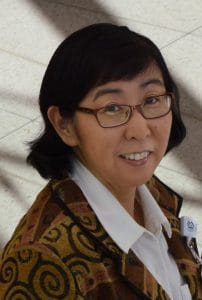UAMS Researcher’s HPV Vaccine Holds Promise for Saving Lives, Preventing Premature Births
| LITTLE ROCK — A human papillomavirus (HPV) vaccine, discovered by a University of Arkansas for Medical Sciences (UAMS) researcher and recently shown to be safe, is being made available to a larger group of Arkansas women for further testing.
In her recently completed phase I study involving 34 women, researcher Mayumi Nakagawa, M.D., Ph.D., demonstrated the drug’s safety and got a glimpse of its promise for curing HPV patients. Supported by the National Institutes of Health (NIH), Nakagawa’s research will receive an additional $3.5 million over the next five years.
In the phase II clinical trial now underway, Nakagawa’s vaccine will be tested in 80 patients with precancerous cervical lesions. She is seeking women ages 18 – 50 whose Pap smears show high-grade squamous intraepithelial lesions (HSIL), or that HSIL cannot be ruled out.
Women interested in participating in learning more about the study may contact Shawna Owens, (501) 526-7657 or email owensshawnas@uams.edu.
Nakagawa’s vaccine differs from an existing HPV vaccine for women or girls who have never been exposed to HPV and don’t have the virus. Her vaccine is designed to cure HPV, cause the pre-cancerous lesions to disappear, and provide future protection against HPV.
If proven effective, the vaccine could significantly reduce the incidence of preterm births. It would do so by giving women an alternative to surgical treatment for HPV-related precancerous lesions called HSIL. Surgery increases the incidence of preterm delivery from 4.4 to 8.9 percent.
For women who still plan to have children, a therapeutic vaccine such as the one being developed by Nakagawa could become the first line of therapy when it is approved by the Food and Drug Administration (FDA).
HPV, a sexually transmitted virus, is associated primarily with cervical cancer, the fourth-most common cancer in women worldwide. Cervical cancer is almost always caused by HPV, which also causes anal, oropharyngeal, penile, vaginal and vulvar cancers. It is estimated to be responsible for 5.2 percent of cancer cases in the world.
During the phase I safety study, Nakagawa saw the vaccine’s potential effectiveness.
Patients were divided into groups that received different dosages. For those who got the lowest dose — which was determined to be the most effective — their precancerous lesions disappeared in half of the patients in three months. The vaccine also appeared to be effective against the most aggressive form of HPV, she said.
At three months, however, Nakagawa could no longer track the vaccine’s effect on the precancerous lesions because the study participants had the lesions removed in a surgical procedure. Given more time to observe the patients who received the vaccine, Nakagawa believes the number of patients in which the lesions disappeared could double as shown in similar study, essentially curing them.
“It could be nearing 100 percent regression at six months,” she said. “In phase II we’re extending the observation period to 12 months.”
If at 12 months there’s no evidence of the virus or cervical lesions, study participants will be considered cured and not have the surgical procedure. This will leave the cervix intact and lower the risk for a future preterm delivery. For women who don’t respond to the vaccine, the study will pay for them to have the surgical procedure.
Nakagawa’s HPV research is also supported by the UAMS Translational Research Institute, which has provided pilot funding and a full-range of research services, including study planning and coordination, nursing, regulatory startup and budget development.
UAMS is the state’s only health sciences university, with colleges of Medicine, Nursing, Pharmacy, Health Professions and Public Health; a graduate school; a hospital; a main campus in Little Rock; a Northwest Arkansas regional campus in Fayetteville; a statewide network of regional campuses; and eight institutes: the Winthrop P. Rockefeller Cancer Institute, Jackson T. Stephens Spine & Neurosciences Institute, Harvey & Bernice Jones Eye Institute, Psychiatric Research Institute, Donald W. Reynolds Institute on Aging, Translational Research Institute, Institute for Digital Health & Innovation and the Institute for Community Health Innovation. UAMS includes UAMS Health, a statewide health system that encompasses all of UAMS’ clinical enterprise. UAMS is the only adult Level 1 trauma center in the state. UAMS has 3,485 students, 915 medical residents and fellows, and seven dental residents. It is the state’s largest public employer with more than 11,000 employees, including 1,200 physicians who provide care to patients at UAMS, its regional campuses, Arkansas Children’s, the VA Medical Center and Baptist Health. Visit www.uams.edu or uamshealth.com. Find us on Facebook, X (formerly Twitter), YouTube or Instagram.###
